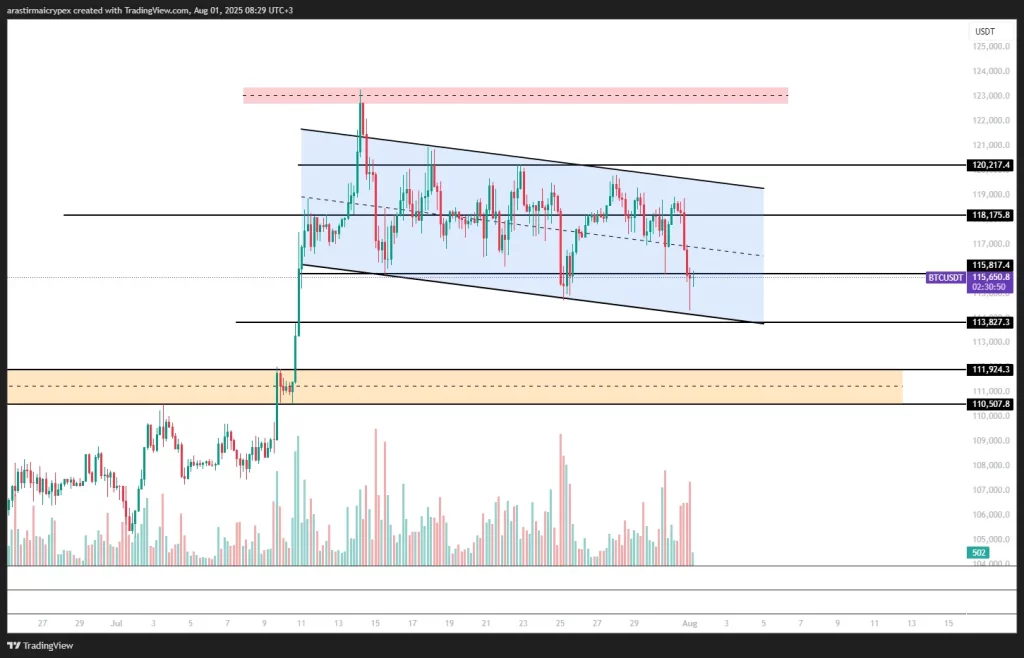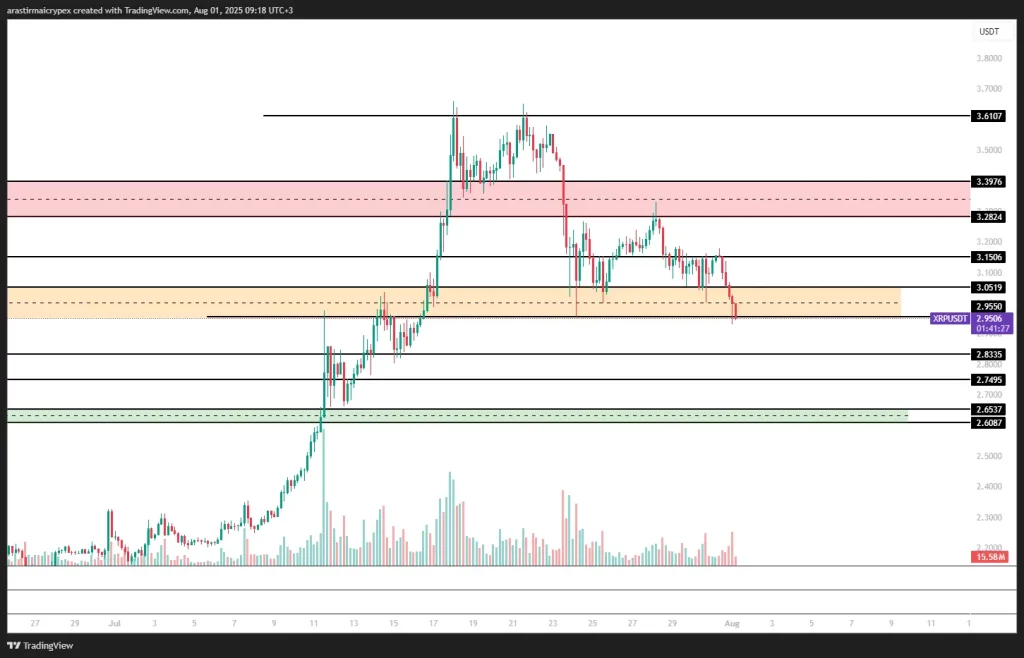Trump Imposes New Tariffs on Goods from 92 Countries
US President Donald Trump has imposed new tariffs ranging from 10% to 41% on goods from 92 countries. The duty rate on goods from Canada was raised from 25% to 35%. The Canadian Prime Minister described this increase as “disappointing” and announced that his country would diversify its export markets. Trump also imposed a general 10% tariff on products from countries other than the US. However, Mexico was given a 90-day reprieve, during which time trade agreements will be further developed.
Trump’s decision is aimed at correcting the trade imbalance, and the President has stated that he aims to make more trade agreements with some countries. On the other hand, these higher tariffs could directly affect some of the world’s poorest countries and increase economic hardship. Countries such as Brazil, India, and Taiwan are among the others affected by the new tariffs.
SEC Chairman Atkins Aims to Update Crypto Regulations with Launch of “Project Crypto”
U.S. Securities and Exchange Commission (SEC) Chairman Paul Atkins has launched a new initiative called “Project Crypto,” which aims to transition the country’s financial markets to on-chain systems. The project was shaped by a report recently released by the Presidential Task Force. Atkins stated that this initiative aims to make America a leading place for entrepreneurs and support participation in capital markets through advanced technologies.
“Project Crypto” aims to develop rules that will allow the SEC to assess the economic realities of crypto assets by placing them in categories such as digital collectibles, digital commodities, or stablecoins. It also plans to revamp existing regulations to ensure the effective use of on-chain software systems in financial markets. Atkins emphasized that the SEC will aim to integrate decentralized finance (DeFi) and similar “on-chain” software systems into the market while avoiding unnecessary regulations.
Strategy (MSTR) Earns $10 Billion in Q2 Profit
Strategy (MSTR), the largest institutional holder of Bitcoin, reported $10 billion in net profit in the second quarter, or $32.60 per share. This massive gain was fueled by a 30% increase in Bitcoin’s price. The company earned $14 billion during the quarter and continued its aggressive Bitcoin accumulation plan. Strategy, led by Michael Saylor, raised its year-end Bitcoin price forecast to $150,000 and set its year-end net profit target at $24 billion.
The company’s Bitcoin holdings reached 628,791 BTC as of the end of July, generating a 25% return on Bitcoin in the first six months. Gains from the $14 billion in operating income in Q2 and the rise of Bitcoin led Strategy to raise its 30% Bitcoin return target for the year. The company’s share price has risen 34% since the beginning of the year, reaching $408.25 in after-hours trading.
Tether Earns $5.7 Billion in Profit and Makes $127 Billion in U.S. Treasury Investments
Tether delivered a strong financial performance, reporting a $5.7 billion profit in the second quarter of 2025. Since the beginning of the year, the company has minted $20 billion worth of new USDT, reaching a total circulation of $157 billion. Tether also holds $127 billion worth of US Treasury securities during the same period, reflecting the company’s significant exposure to US government debt instruments.
The majority of Tether’s profit came from operating income ($3.1 billion) and market gains from investments in gold and Bitcoin ($2.6 billion). Furthermore, the company’s shareholder capital remained at $5.47 billion, providing a strong financial buffer against market shocks.
Visa Adds Avalanche and Stellar Support
Visa expanded its stablecoin payments infrastructure, adding support for PYUSD, USDG, and EURC tokens, and integrating the Avalanche and Stellar blockchains into the system. Visa, which had previously only been able to process transactions on the Ethereum and Solana networks, aims to further strengthen its stablecoin infrastructure and increase institutional adoption with this move.
Rubail Birwadker, Visa’s global Head of Growth Products and Strategic Partnerships, stated that stablecoins could fundamentally transform global payment systems when they are trustless, scalable, and compatible with each other. This development follows the passage of the GENIUS Act for stablecoins in the United States and has further established Visa’s presence in the crypto world.
Justin Drake’s 10-Year ‘Lean Ethereum’ Roadmap
Ethereum researcher Justin Drake unveiled his “Lean Ethereum” plan for Ethereum’s 10th anniversary, aiming to increase transaction speed while strengthening the network’s security. This roadmap aims to provide performance improvements and scalability gains to enable Ethereum to survive against post-quantum threats. Drake is dividing the network’s core layers into three protocol sublayers, targeting Ethereum to process up to 10,000 TPS and 1 million TPS at Layer-2.
The roadmap consists of three main sublayers: Lean Consensus (Beacon Chain 2.0), Lean Data (Blobs 2.0), and Lean Execution (EVM 2.0). These sublayers aim to improve security, data scalability, and transaction verification, respectively. Hash-based cryptography, the cornerstone of this structure, will provide security against future quantum threats while also increasing the network’s speed.
Spot Solana ETF Applications Resubmitted, Liquid Staking Features Under Evaluation
Seven major asset managers, including Grayscale, VanEck, Bitwise, Canary, Franklin Templeton, Fidelity, and CoinShares, have resubmitted Form S-1s for their Spot Solana ETF applications with the SEC. This move suggests the firms are continuing their efforts to expand their crypto ETF offerings beyond Bitcoin and Ether. Experts predict a 95% chance of SEC approval, but uncertainty remains regarding the integration of staking features.
Major asset managers such as BlackRock are demanding staking features be added to their existing Ethereum ETFs, while Solana-based ETPs are also lobbying intensely for liquid staking features. Liquid staking will maintain the liquidity of staked tokens, enabling more efficient capital allocation and providing investors with greater security and choice.
Mill City Ventures Acquires 76.3 Million SUI on Sui Blockchain
Following its $450 million private placement, Mill City Ventures acquired 76.3 million SUI tokens, becoming the first public company to launch a crypto treasury strategy backed by the Sui Foundation. The company made this investment in collaboration with hedge fund Karatage and offered SUI tokens in a structure that provides daily liquidity for retail and institutional investors.
Mill City’s treasury holdings currently exceed $277 million and plans to continue accumulating funds through OTC and open market purchases to make the Sui network directly accessible. Sui has reportedly seen early interest in institutional use in areas such as stablecoins, gaming, and artificial intelligence. Mill City’s strategy aims to create long-term value through active collaboration with the Sui ecosystem.
SharpLink Gaming Purchases 11,259 ETH for $43 Million
SharpLink Gaming spent 43.09 million USDC to purchase 11,259 ETH through Galaxy Digital, bringing its total ETH reserves to 449,276, valuing it at approximately $1.73 billion. This purchase follows the company’s previous large purchase of 77,210 ETH, and SharpLink remains a major player among institutional ether treasuries.
This purchase comes at a time when the total value of Ethereum treasuries has surpassed $10 billion, with 64 institutions accumulating ETH. SharpLink’s move comes amid growing institutional crypto adoption, and experts predict the race to accumulate ETH will continue.
Philippines Launches Blockchain Technology for Document Verification on Polygon Network
The Philippine government has launched a blockchain-based document verification platform on the Polygon network. The move is part of its efforts to use emerging technologies such as artificial intelligence (AI), satellite imaging, and blockchain to improve public administration and policymaking. The government emphasizes that blockchain has the potential to address the problem of AI deepfakes and prevent malicious actors from creating fake documents.
Developed in collaboration with local tech startup Bayanichain, the system allows citizens and stakeholders to verify the authenticity of important government documents using a public ledger on the Polygon blockchain. The platform marks each document with a unique “fingerprint” (hash), and this hash ensures unchangeable verification of the documents.
—————————————————————————————————
BITCOIN (BTC)
Bitcoin is traded at $115,648 as of the morning hours, losing 0.10% of its value. BTC, which declined yesterday evening, is operating below the $115,817 support. If the decline continues, the 114,150-113,830 area can be expected to act as support. If a break from here, the $111,925 levels remain the next support position.
In a possible positive movement, it will be important to first break the 115,817 resistance and maintain stability above it. Then, $ 116,835 and $ 118,175 levels can be targeted.

ETHEREUM(ETH)
ETH is priced at $3,669 as of the morning hours with a 0.76% loss in value. The price has now retreated, facing resistance from the $3,756 levels, and may test the $3,544 level. This region will be watched as a strong support in the near term. If this support level breaks, a pullback towards the $3,452 and $3,323 levels is possible.
On the other hand, if it stays above the $3,670 level, a new rise above is possible towards the $3,756 and $3,867 levels.

RIPPLE(XRP)
XRP is priced at $2.95 as of the morning hours with a 2.38% loss in value. If this level is lost for XRP, which is at the immediate support level, it can be expected to test the levels of $2.83 first and then $2.74.
Holding above 2.95 will be critical for a possible positive trend. Then the $3.05 and $3.15 levels can be met as the next resistance levels.

AVALANCHE(AVAX)
AVAX is trading at $21.88 with a 2.63% loss as of the morning hours. The price moved down from the $22.59 level. If the decline continues, the $21.52 level can be expected to work as the first support. If the price breaks this level, a decline down to $20.33 is possible.
On the other hand, if the price climbs above the $22.59 level, the $23.22 and $23.91 levels can be watched as resistance points, respectively. These levels will be important levels to monitor for a possible upward movement.

SOLANA(SOL)
SOL is trading at $168 levels with a 2.32% loss as of the morning hours. The price seems to have tested the $169.55 level after the recent pullback. If this level fails to hold, the next support zone is at $167.40 and below $162.01.
On the other hand, if the price stays above the $169.55 level, the price is likely to move upwards again and target the $173.71 level. If this level is broken, resistance levels can be observed at $177.70 and $184.95.
